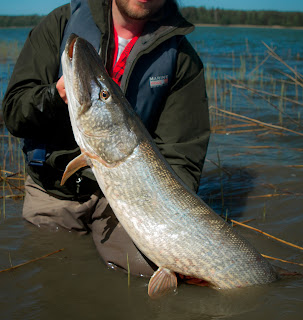Learning curve
Hi all! I have not updated my blog in a while, but thought I'd give it a shot now.
Over the years I've become obsessed with tying big flies for predators like pike, tuna and striped bass. I have tried a lot different things and techniques and with time chosen the ones that suit my thing.
I have not cracked the code completely and probably never will, but there are three major things about tying big flies that I have managed to get in a shape that I can say that they work. Please remember that these are just my thoughts and experiences on this subject and should not be thought as the one and only way to do things.
The learning curve is still in motion but here are a few points that have become important for me:
1. Taper. The correct taper in a baitfish pattern not only looks good, but it keeps the fly as foulproof as possible. Having a fly on the end of your line that does not tangle always increases your odds :)
2. Castability. A fly 9-10" long will never be as nice to cast as a smaller one, but there are a few things that you can do to make a big fly that casts nicely. The fly must "breathe", so the materials need to be tied in a way that they have room to move and "collapse" in to a tight package when airborne. Natural materials like rooster hackle, ostrich and bucktail work very well this way. Second thing to think about is the weight/wind resistance ratio of the fly. The bigger the fly stays while airborne the more weight it needs to fly nicely, especially in to the wind. So even though many synthetics don't absorb any water they are actually many times harder to cast then naturals that weigh more, because they don't "collapse" as well as the naturals do when airborne. To overcome this problem synthetics need more weight. So either use a bigger hook or add lead on the hook shank to keep the ratio right. Try different things to find out the right ratio. I have no exact formula for this to offer.
3. Movement. I just like a fly that moves nicely. Who doesn't!! Using materials that move is of course important, but so is the way you tie them. The materials need to have room to move!
Here's a few clips of my flies in the water.
Well now, how to tie these things... Here's a shitty video of one been tied and lots of example flies that I've tied. I have been heavily influenced by Bob Popovics and by a student of he's work Andrew Warshawer. I also stole the idea of making heads out of dubbing from Jonny King. Those guys rock! Thanks for reading this and I'll try to come back with more shortly...
Over the years I've become obsessed with tying big flies for predators like pike, tuna and striped bass. I have tried a lot different things and techniques and with time chosen the ones that suit my thing.
I have not cracked the code completely and probably never will, but there are three major things about tying big flies that I have managed to get in a shape that I can say that they work. Please remember that these are just my thoughts and experiences on this subject and should not be thought as the one and only way to do things.
The learning curve is still in motion but here are a few points that have become important for me:
1. Taper. The correct taper in a baitfish pattern not only looks good, but it keeps the fly as foulproof as possible. Having a fly on the end of your line that does not tangle always increases your odds :)
2. Castability. A fly 9-10" long will never be as nice to cast as a smaller one, but there are a few things that you can do to make a big fly that casts nicely. The fly must "breathe", so the materials need to be tied in a way that they have room to move and "collapse" in to a tight package when airborne. Natural materials like rooster hackle, ostrich and bucktail work very well this way. Second thing to think about is the weight/wind resistance ratio of the fly. The bigger the fly stays while airborne the more weight it needs to fly nicely, especially in to the wind. So even though many synthetics don't absorb any water they are actually many times harder to cast then naturals that weigh more, because they don't "collapse" as well as the naturals do when airborne. To overcome this problem synthetics need more weight. So either use a bigger hook or add lead on the hook shank to keep the ratio right. Try different things to find out the right ratio. I have no exact formula for this to offer.
3. Movement. I just like a fly that moves nicely. Who doesn't!! Using materials that move is of course important, but so is the way you tie them. The materials need to have room to move!
Here's a few clips of my flies in the water.
Well now, how to tie these things... Here's a shitty video of one been tied and lots of example flies that I've tied. I have been heavily influenced by Bob Popovics and by a student of he's work Andrew Warshawer. I also stole the idea of making heads out of dubbing from Jonny King. Those guys rock! Thanks for reading this and I'll try to come back with more shortly...











Nice patterns. Greetings.
ReplyDeleteI have read your article very attentievely really this is very informative article.Just read your article. Good one. I liked it. Keep going. you are a best writer your site is very useful and informative thanks for sharing!
ReplyDeleteMy blog: best saltwater spinning reel